
Dashboard 1 (Ctrl+F4)
The Dashboard screen (Miscellaneous>Show Quick Keys>Dashboard) is a single-screen view of essential reservation related data available by pressing the Ctrl+F4 quick key from anywhere within the Opera application.
Note: The Reservations>Reservation View needs to be granted to access the Dashboard (Ctrl + F4) Quick Key. If only the Reservations>Reservation Edit permission is the only permission granted to the user, then they will not have access to the Dashboard (Ctrl + F4). And if both the Reservation>Reservation View and Reservations>Reservation Edit permissions are granted, then the user will be able to access the Dashboard (Ctrl + F4).
From this one screen you can handle core activities such as making new reservations; locating, updating and canceling reservations; requesting and applying deposits; processing guest check ins and check outs; pre-allocating rooms; managing guest billing; running reports; working with housekeeping; and reviewing and referencing availability, day types, and house status for today or any future date. You can easily verify guest names, whether they have checked in, and their room numbers. Volumes of other important information — such as guest profiles and stay histories — are available from the Dashboard, without returning to a menu!
All your guest interactions can be managed from one easy-to-find quick-key screen to ensure relevant and timely information is available to your staff. The Dashboard is designed for speed so your focus is your guest.
Alternative Dashboard layouts are available. Which layout you see depends on the General>Dashboard Layout View application setting. This layout is available when the General>Dashboard Layout View application setting is set to Dashboard 1.
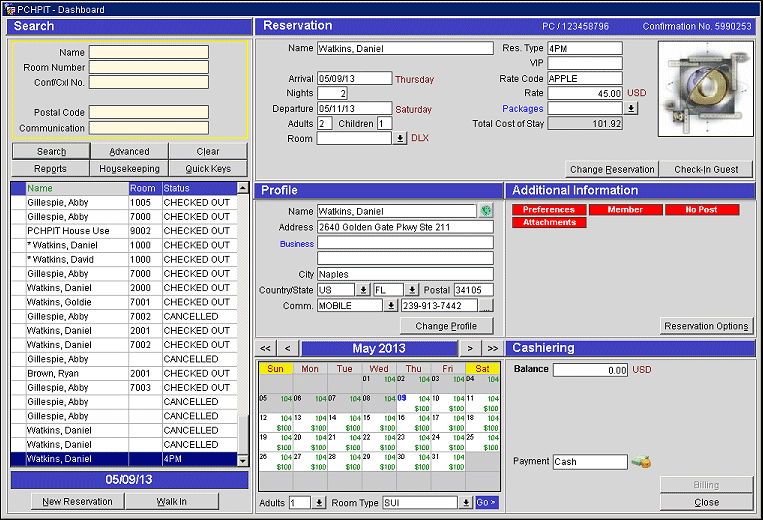
Following is a description of the Dashboard features for Layout 1. Many of the fields and buttons in each of the Dashboard sections are the same as those found on other Opera screens such as the Reservation screen, the Profile screen, and the Billing screen. Please see the descriptions of these screens for complete details.
Use the Search panel on the left part of the Dashboard to locate reservations.
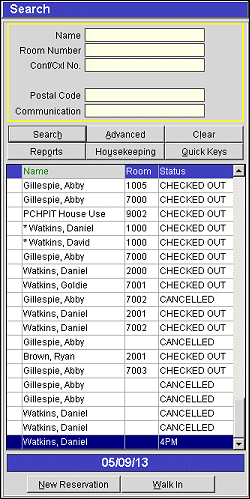
Enter your search criteria and select the Search button. If you select the Search button without entering any search criteria, the Dashboard displays all reservations for today's date, including reserved, checked in, cancelled, due out, and checked out. Multiple numbers can be searched when using the Room Number, Confirmation, or CRS Number fields by inserting a comma between each set of numbers.
Use the Clear button to remove all search options currently specified, including those that may be defined on the Advanced panel of options.
Name. The guest's or accompanying guest's last name. If you are unsure of the correct spelling, enter only the first few letters. The results for a search based on a last name are ordered by reservation arrival date, then by last name, then by first name.
Note: When searching on a guest's last name as the only search criteria entered, the search result will return any reservations that have a departure date in the past three days of the current business date will also be returned in addition to any future matching reservations. To find older reservations, enter more search criteria.
Room Number. The room number assigned on the reservation. Multiple room numbers can be entered separated by a comma. For example, if you want to search for Rooms 1001 and 1008, enter 1001, 1008 and select the Search button to return only those two rooms.
Note: When searching on room number only, all future reservations for that room number will be returned in addition to any reservations that have a departure date in the past three days of the current business date for the room number will also be returned. To find older reservations, enter more search criteria.
Conf/CXL No. The confirmation or cancellation number for the reservation. One or more specific confirmation or cancellation numbers can be searched on at a time by entering a comma between each number. (For a really fast search all you need is the reservation confirmation or cancellation number.)
CRS Number. The GDS transaction number or other central reservations system transaction number associated with the reservation. One or more specific CRS numbers can be searched on at a time by entering a comma between each CRS number. (The CRS Number field appears as a standard search option if a CRS interface is installed.)
Postal Code. Enter the entire postal code for the guest's address (e.g., 34105).
Communication. Use this field to search by any communication type (e.g., Phone, Fax, Email) associated with the guest's profile.
Select the Advanced button to display additional search options. Advanced search features let you narrow or expand your search.
First Name. First name of the guest. This field can be helpful if the guest has a common last name like Smith.
Company. Name of the company associated with the reservation.
Agent. Name of the travel agent associated with the reservation.
Group. Name of the group associated with the reservation.
Block. Block code associated with the reservation.
Arrival Date From/Arrival Date To. Define the range of arrival dates you wish to search. By default, the Dashboard displays all reservations for today's date, including reserved, checked in, cancelled, due out, and checked out.
Departure Date From/Departure Date To. Define the range of departure dates you wish to search.
Credit Card #. Manually enter, or swipe the guest's credit card, to search for the reservation by the credit card number attached to the reservation. When the ![]() icon is displayed at the end of the field, this means the Credit Card Vault functionality is active. See Credit Card Vault for details.
icon is displayed at the end of the field, this means the Credit Card Vault functionality is active. See Credit Card Vault for details.
CRS Number. Available when the OPR_<version number> Opera Reservation System license is active, GDS transaction number or other central reservations system transaction number associated with the reservation. One or more specific CRS numbers can be searched on at a time by entering a comma between the CRS numbers.
Custom Ref. External CRS system reference number associated with the reservation.
Membership. Select the down arrow to choose a membership type.
Membership Number. Enter the membership number. If no membership type has been selected in the Membership field, the membership type in the Profiles>Default Membership Type application setting is assumed. If the guest has a membership card, position your cursor in the Membership Number field and swipe the card. Opera will populate the Membership Number field with that membership number.
Party. Available when the Reservation>Party application function is set to Y, to display all party members, enter the name of the party only. To narrow your search, enter the name of the party along with other search criteria.
Show Waitlist. Available when the Reservations>Waitlist application function is set to Y, select this check box if you wish to display only waitlisted reservations that meet other search criteria.
Search Type. Select the radio button that corresponds to the reservation status of the reservations you wish to display. These options may be used to filter other search criteria. Search Type options are not available if you have selected the Show Waitlist check box.
Click in the search results grid headers to re-order the display by last name, room number, or reservation status. (By default, search results are ordered by last name, first name, and arrival date.)
Color Code. The Reservations>Reservation Color Definition application setting can be set to Reservation, VIP Level, Market Code or None. Depending on the setting, a color may appear in this column to indicate a reservation, market code, or VIP status or condition agreed on by the property. For example, colors may be used as a quick reference to see if a guest is disabled or if the reservation belongs to a dignitary. The color and its definition appear in the Reservation section of the Dashboard when the guest's record is highlighted in the search results grid.
Name. Guest's name.
Room. Guest's room number.
Status. Reservation status.
Reports. The Reports button gives you access to the complete set of Opera reports, setup for the Dashboard Report Group, without closing the Dashboard. Reports can be previewed, printed, emailed, and faxed at any convenient time using this option.
Housekeeping. Go directly to the Housekeeping screen by selecting this button. From there, room statuses can be checked or modified.
Quick Keys. Select this button to go to the Quick Keys menu. Quick Keys help you quickly accomplish tasks you perform frequently, no matter where you are working in Opera, without leaving the task you are currently working on. (See Quick Keys for details.)
New Reservation. Select the New Reservation button to begin making a new reservation. The reservation flow that ensues depends on the Reservations>Reservation Flow application setting for the property. When the Reservations>Profile Search Prior to New Reservation application setting is set to Y, you must select a profile from the Profile Search screen before a new reservation can be made.
Walk In. Select this button to check in guests who arrive without previously having made a reservation. The reservation flow that ensues depends on the Reservations>Reservation Flow application setting for the property. You are prompted to select a room and to check in the guest as part of the reservation making process. (See Walk In for details.)

The reservation section provides an overview of the reservation details.
"Smart" Buttons. Reservation section buttons behave intelligently to give you access to the features you need based on the reservation status of the guest highlighted in the Search section. This feature assists users (including new users) in doing their jobs efficiently. For example, if the reservation is checked in, the Change Reservation button displays, allowing you to update the reservation; the Cancel Check-in button lets you reverse the check in — but only if guests have no charges on their account. When working with a checked out reservation, the Reinstate button is available. For due in reservations, the Check In button and Cancel button are available. Even the Room field down arrow is aware whether the current reservation is reserved, checked in, or due out. When a Check In message is available for the Due In reservation, the check in alert for the reservation will automatically display when the Check In button is selected. For reserved guests, the button lets you select a room. For checked in guests, the button lets you handle a room move. And no button appears for due out guests. For no shows, the room number is irrelevant so the Room and Room Status fields disappear.
Note: Selecting the Change Reservation button on a multi room reservation will ask if it is OK to split the reservation. The reservation split will be saved, even if the reservation is exited out of without being saved.
Confirmation No. Confirmation No. of the reservation is displayed in the title bar of the Reservation Section.
Name. Reservation name.
Company. If a company profile has been associated to the reservation, then the company profile name will display here.
Arrival. Arrival date. The corresponding day of the week displays next to the defined arrival date.
Nights. Number of nights the guest is staying.
Departure. Departure date. The corresponding day of the week displays next to the defined departure date.
Adults. Number of adults on the reservation.
Children. Number of children on the reservation.
Room. If the guest has not yet checked in, select the down arrow to display the Available Rooms Search screen. The screen displays room numbers for the selected room type, along with room features, floor number, reservation status, and current housekeeping status associated with each. You may search to identify inspected rooms, smoking and no smoking rooms, and rooms with specific features such as a particular view.
The Room field shows with a red background if the room is designated Do Not Move. (Available when the Reservations>Do Not Move Room application function is set to Y.)
When assigning a room to a Share Reservation with different arrival and departure dates, the room will be assigned to all of the reservations in the share according to their arrival and departure dates.
To the right of the Room field is the room type for the selected room number. Click on this hyperlink to display room type details. (See Image Maintenance for details.) The Room field will not be visible should the currently displayed reservation have a status of No Show.
Note: When the OPV_<version number> Opera Vacation Ownership System license code is active and a room number is manually typed in that is not the first unit in rotation, then the Rotation Room Override prompt will display for a reason as to why that room was selected (See Rotation Room Override for details).
Change of Room Type to Charge. When the Reservation>Room Type to Charge application parameter is set to Y, Opera implements the addition of the RTC field on the Reservation screen. By using this field it is possible to have the reservation be inventoried on one room type, but charged as if it was another room type (the room type specified in the RTC field). When you move a guest's reservation to a room which has a different room type, a prompt appears: "Room type has been changed to <new_room_type>. Do you want to change RTC to <new_room_type>?" Respond Yes to continue with the move and change the RTC to the new room type (Yes is the default). Respond No to continue with the move without changing the RTC from what appears on the Reservation screen. This feature is available only if the RTC on the Reservation screen matches the room type shown on the reservation prior to the move.
Room Status. Show the Housekeeping status of the assigned room. The background color of this field will indicate the status at a glance: Dirty is red; Pickup (available if the Rooms Management>Pickup Status application function is set to Y) is yellow; if the Rooms Management>Inspected Status application function is set to Y, Inspected is green and Clean is cyan; if the Rooms Management>Inspected Status application function is set to N, Clean is green.
Note: The Room Status field will be visible only during the period from the arrival date (once a room number has been assigned) through check out.
Res. Type. Reservation type; following check-in, the reservation status.
VIP. Reservation VIP level. Available when the Profiles>VIP application function is set to Y.
Confirmation. Reservation confirmation number.
Rate Code. Reservation rate code. When multiple rate codes and/or rate amounts exist for the reservation, the Rate Code/Rate fields are highlighted in yellow. When the date for which the changed rate is past, the Rate Code/Rate fields return to white background.
Note: When the Membership > Awards application function is active (set to Y), the Rate Code/Rate fields remain highlighted in yellow when any multiple rate codes or rate changes exist at any point over the course of the stay, whether current, past, or future.
Rate. Room rate for the rate code and room type for the reservation. Should the Reservations>View Suppressed Rate Details user permission not be granted, SR is displayed instead of the actual rate. See Suppressed Rates for details.
Note: If the Rates>Multi Currency application parameter is set to Y and rate codes are configured in various currencies, the rate amount displayed is based on the currency of the rate code.
Packages. Select the down arrow to display the Packages screen. This screen lists any packages associated with the reservation, either attributable to the rate code that has been selected or added separately to the reservation. When a package is configured as part of the rate code, the rate is inclusive the package price is included in the rate. Only the packages that cover the dates of the reservation are displayed in the Packages list of values.
When a Package is attached to a reservation and the stay dates are updated and fall outside of the start and end dates of the Package, then a message is displayed stating "An attached package does not have package details associated for this time period." After closing the message, the cursor is taken back to the Nights field and the number of nights is changed back to the reservations original amount.
Total Cost of Stay. This field’s visibility on the Reservation Dashboard is determined by the property’s configuration for Menu and Screen Design for the Reservation Dashboard 1 screen attributes. If the Total Cost of Stay is selected to be hidden within this configuration, the field will not be shown in the Reservation Dashboard. When shown, this read-only display shows the reservation’s Total Cost of: Lodging + Packages + Fixed Charges (No, if deposits are considered then we would be showing the guest pay own total) The Total Cost of Stay amount will also correspond with the Total Cost of Stay field displayed within Rate Info screen, and the Total Cost of Stay merge code within the Closing Script. See Rate Information for more information. The Total Cost of Stay field is displayed for all reservation statuses excluding Cancelled, Checked Out, No Show and those reservations with Pseudo room types.
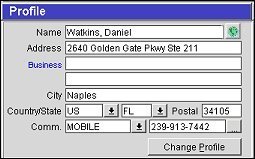
When the OPR<version number>ORS license code is active and the Protected field for the profile has been selected as CENTRAL, this protects this profile from changes being made at the PMS property level (details are explained below). When this profile is saved after CENTRAL Protect has been selected, the profile is identified with a green label "Protected" on both the ORS and PMS Profile Screen.
When a profile is Central Protected, only certain changes can be made to unprotected fields at the PMS property level, such as owner, routing instructions, commission, Profile Options, negotiated rates, comments, or preferences. These changes update the PMS profile and also transfer to and update the ORS profile. When the Profiles>Full Protection application parameter is set to N, changes cannot be made at the PMS property level to protected fields, such as the Last Name, First Name, Company, Address, Country, State, Communication Types, Name Code, VIP, or Profile Type. To restrict any changes at all from being made at the PMS level to a Central Protected profile (including unprotected fields of owner, routing instructions, commission, Profile Options, negotiated rates, comments, or preferences), an application parameter Profiles>Full Protection can be set to Y in PMS so no fields can be modified.
Direct Entry Fields. You can directly edit or delete address and communication information fields right on the Dashboard. You may also add addresses and phone numbers (e.g., home addresses, business addresses, mobile phone numbers, business phone numbers, email addresses, etc.). Changes made here are automatically saved to the profile.
Name. Name of the guest associated to the reservation. This field cannot be edited as it is view only. The Name label will be blue when there is Alternate Name information for the displayed Profile/Reservation. Select the Globe button to display the Alternate Name for the guest, for example:
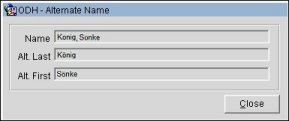
Address. Enter the guest's address (mailing address) city, postal code and extension, country, and state. Please note that if postal codes for the city, state, and country have been configured in Configuration>Profiles>Geographic Data>Cities and Postal Codes, if you enter an existing postal code the city and state will automatically populate. If you enter an existing postal code that exists for more than one city or state, the first city or state configured automatically populates; you can then change to the other configured city or state, if necessary. If you enter an existing postal code, but it doesn't match the current state, a message displays such as "Postal Code is not in the valid range." If you enter a postal code that has not been configured, you may enter any state and city without an error message. If multiple addresses are available for this profile, the Addresses lamp appears (in red) in the lower part of the screen (See Indicator Lamps for details). (See Addresses for details.) If multiple addresses are created, select one as the primary address. The primary address displays on the Profile screen with the address type (shown in blue: for example, Home Address, Business Address) next to it. The default primary address type is set by the Profiles>Individual Address Type application setting.
Address. Enter the guest's street address.
City. Enter the city portion of the guest's address.
Postal Code. Postal code portion of the guest's address.
State/Province. Select the down arrow to choose the state or province portion of the address, if applicable.
Country. Select the down arrow to choose the country portion of the guest's address. If an ISO country code is associated with the country code you select here, the appropriate national flag image will appear next to the Country field and list of values down arrow, if this option has been configured (see Countries for details).
Comm. In the Comm. field, if a primary phone number does not exist, then the primary email is displayed. If a primary email does not exist, then the primary fax is displayed. Select the ellipsis button to see complete communication information.
Note: A double click on the email address (when the Comm. field is set to EMAIL) launches a new email to be sent to the guest's email address. This feature is also available in the Profile screen.
Change Profile. Select this button to display the complete guest profile for review or editing.
Note: All changes made to this section of the Dashboard, whether they are additions, modifications, or deletions, will be reflected throughout the rest of Opera.
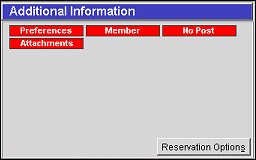
Lamps. Red indicator lamp buttons (such as Share, Comments, Preference, Profile Notes, Attachments, and many more) display in this section for any options that apply to the current reservation or profile. Click on the lamp to access the underlying details for viewing or editing (See Indicator Lamps for complete list and details).
Reservation Options. The Reservation Options button displays the full menu of options that apply to the current reservation. (See Reservation Options for details.)
Key Info. When the Reservations>Cashiering Flow at Check In / During Stay application setting is set to Force Advance Bill or Force Advance Bill and Payment, and there is a key interface configured and active at the property, a view-only field shows the date through which the key generated for this reservation is valid and the key PIN code in the following format: Key valid date / Key PIN code. See Force Advance Bill and Payment at Checkin and Force Advance Bill for details.
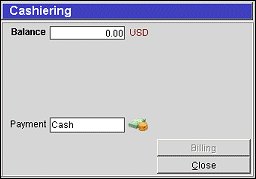
Note: The Cashiering>Bypass Cashier Login application parameter may be used to speed access to Cashiering functions for users having a cashier ID associated with their user ID. If the Cashiering>Bypass Cashier Login application parameter is set to Y, and if you have previously logged in to Cashiering and the Cashier is still open, the Cashier Login screen does not appear when subsequently accessing Cashiering functions. If Bypass Cashier Login is set to N (the default), you are prompted for a Cashier Login each time a Cashiering function is accessed.
Balance. A current total balance for the guest is displayed for quick reference at the top of the Cashiering section, along with window-by-window breakdowns, as applicable. A currency code displays for balance amounts when the General>Multi- Currency application function is set to Y.
Routing Codes. If a routing code has been configured for one or more of the guest's billing windows, they are shown in blue type. To set up or review routing options, the Routing button is available from the Reservation Options menu, and the Routing lamp is available in the Additional Information section.
Payment. The payment method as entered on the reservation details is displayed. When payment methods that are to be displayed screen have a display code assigned to their respective transaction codes, then an image will be displayed beside this field.
Billing. This button takes you to the Billing screen. The Billing button is available in the Cashiering section for checked in reservations. If the Cashiering>Pre Stay Charges and/or the Cashiering>Post Stay Charges application functions are set to Y at the property, and if the reservation conforms to the pre stay and/or post stay charging rules, the Billing button is available for reservations that have not yet checked in, or that have checked out. (See Pre Stay Charging and Post Stay Charging Rules for details.)
Check Out. This button takes you to the Billing screen. The Check Out button is available in the Cashiering section if the current guest is scheduled to check out today.
The availability calendar section shows rate and availability information, as appropriate, for the current month. The buttons may be used to change the display for a different month and/or year:
Month. Click on the month to go to the Detailed Availability screen. The Detailed Availability screen shows a 14-day view of the availability of each of the property's Room Types by day, along with relevant statistics for the day. The current business date is the default start date for the display.
Date Blocks. The date is shown in the upper left corner of each block on the calendar. The current date is shown in blue, while other dates are shown in black.
Available Rooms to Sell. The number in the upper right corner of each date block shows the number of rooms available to sell for that date. By default, the availability displayed is for the room type set by the Reservations>Reservation Dashboard Calendar Room Type application setting but you may check availability for any specific room type by using the Room Type search option below the calendar. If no Reservations>Reservation Dashboard Calendar Room Type application setting is specified, the Available Rooms To Sell defaults to HOUSE (all active room types at the property). If there are rooms available to sell, the availability number is green. A red zero means that there are no rooms of the selected room type available to sell, and a negative red number means that the selected room type is overbooked.
Rate Amount. A rate amount is displayed in the lower right corner in the date block for the room type shown in the Room Type field, and the number of adults shown in the Adults field.
Note: By default, the rates displayed are populated based on the values configured for the Reservations>Reservation Dashboard Calendar Rate Code, Reservations>Reservation Dashboard Calendar Adults, and Reservations>Reservation Dashboard Calendar Room Type application settings. If no Reservation Dashboard Calendar Room Type is selected, HOUSE (total house availability encompassing all active room types at the property) becomes the default. The room type may be changed by making a new selection in the Room Type field. If no Reservation Dashboard Calendar Adults is selected, 1 becomes the default. The number of adults may be changed by making a selection in the Adults field. A Reservation Dashboard Rate Code application setting is not specified, or if the rate code selected has no rate details specified for the calendar dates displayed, or if the room type selected for the Reservation Dashboard Calendar Room Type application setting is not configured for the rate code, rate amounts will not be displayed.
The rate amount is shown in green if there are rooms available to sell for the currently selected rate code/room type/number of adults. A red currency sign appears (e.g., $, ¥, £) in place of a rate amount if there are no rooms available to sell at for the designated rate code/room type/number of adults.
Day Type. Displayed when the Rates>Day Types application function is set to Y, a colored square in the date block indicates the day type (see Day Type Codes for details.) When clicking in a date with a day type in it, the House Status screen is displayed.
Adults. Number of adults that will be associated to the reservation; the default for this number is set by the Reservations>Reservation Dashboard Calendar Adults application setting. Select the down arrow to select a different number of adults for the reservation (maximum of 5). Then select the Go> button. Based on the number of adults selected, rates in the calendar will be refreshed depending on how the rates for each number of adults are defined in the Rate Details.
Room Type. By default, the calendar displays the room type set by the Reservations>Reservation Dashboard Calendar Room Type application setting. If no Reservations>Reservation Dashboard Calendar Room Type application setting is specified, the HOUSE availability (the number of rooms to sell for all active room types at the property) is used by default. You may use the Room Type field to check availability for any active room type at the property. Select the down arrow and choose a room type from the list of values. Then select the Go> button to display availability for that room type.
Go>. Select to refresh the rates in the calendar based on the new number of Adults and/or new Room Type that have been selected.
Show Me